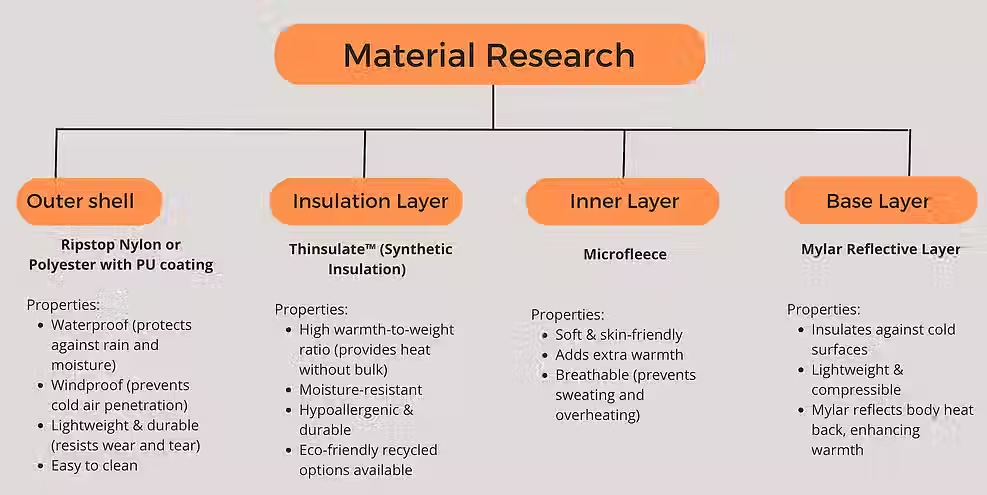
NIGHT
HAVEN
A cost-effective, weatherproof, and insulated sleeping bag with reflective safety strips for pavement dwellers
Problem Statement
Homeless individuals are highly vulnerable to harsh winters, where exposure to extreme cold often leads to hypothermia, frostbite, and even death.
Despite this, there is a lack of affordable, durable, and insulated sleeping solutions tailored for their needs. This project focuses on designing a cost-effective, weatherproof sleeping bag with added safety features, offering warmth, protection, and dignity to those living outdoors.
Discover (Research and Insights)
As many as 10,933 Indians (an average of 781 per year) have died between 2001 to 2014 due to “cold and exposure” , as per the Open Government Data (OGD) Platform of Government of India.

Between November 2024 and January 2025, 474 homeless individuals in Delhi lost their lives to winter exposure, highlighting the urgent need for solutions.

Existing solutions and their drawbacks
-
Traditional blankets: Poor insulation, not weatherproof
-
Low cost bags: Not durable, lack proper insulation
-
Cardboard bedding: No protection from rain and wind
On ground research for sleeping bags and material research
Sleeping bags in stores such as Wildcraft are priced at around ₹3,000, while premium ones with goose feather filling can go up to ₹70,000
The high cost is attributed to the filling inside, but there is a need to bring down the cost keeping in mind our target audience.
.jpg)
Empathise (Users and Pain Points)
To truly understand the problem, we immersed ourselves in the lived realities of homeless individuals who endure harsh winters on the streets. Empathy maps and user personas helped us humanize the data, ensuring our design decisions were rooted in compassion and aligned with the real challenges faced by the homeless community.
User Persona

Empathy Map

Define Stage
We synthesized our insights into a clear problem statement:
“Homeless individuals require an affordable, weatherproof, and insulated sleeping solution that not only provides warmth and comfort but also ensures safety and dignity while sleeping outdoors.”
Key design needs identified:
-
Insulation & Heat Retention: Protection against extreme cold to prevent hypothermia and frostbite.
-
Weatherproofing: Resistance to rain, wind, and damp ground.
-
Portability & Comfort: Lightweight, compact, and easy to carry.
-
Safety Features: Reflective strips for visibility at night, minimizing the risk of accidents for pavement dwellers.
-
Affordability & Durability: Cost-effective materials and construction to ensure longevity without financial strain.

Ideate Stage
We explored various materials for all of the layers of the sleeping bag, comparing their properties amongst eachother.

Ground Sheet (Roto Fabric)
We chose to provide a separate ground sheet made of Roto Fabric rather than attaching it to the sleeping bag. Attaching it would cause folding and crumpling when the bag is rolled, reducing both comfort and durability. A detachable sheet instead offers:
-
Durability: Resistant to rough pavements and frequent use.
-
Waterproofing: Prevents dampness from seeping through the ground.
-
Thermal Insulation: Acts as a barrier against heat loss to cold surfaces.
-
Lightweight & Portable: Easy to fold, carry, and pack without adding bulk.
-
Multi-Purpose Use: Can double as a mat, cover, or temporary shelter when needed.

Reflective Tape
To enhance night-time safety for pavement dwellers, reflective strips are integrated onto the sleeping bag.
-
Visibility: Makes individuals easily noticeable to vehicles in low-light conditions.
-
Accident Prevention: Reduces the risk of cars or bikes running over them while they sleep outdoors.
-
Low-Cost, High Impact: A simple addition that greatly improves safety and dignity.
.jpg)
For insulation, we compared Polyfill and Black Cotton. While Polyfill offers good warmth-to-weight, Black Cotton is significantly more affordable and still provides effective insulation when layered properly. Considering cost constraints and large-scale distribution for homeless communities, Black Cotton was chosen as the more practical and sustainable option.
.jpg)
.jpg)
Prototype Stage
Concepts explored through sketching:
-
Mobility-Enhanced Design: Movement-friendly with removable layers for flexibility.
-
Mummy-Style Design: Tapered shape with a hood for maximum heat retention.
-
Variants: Quilted, flap, coffin style, side-tie, bean-shaped, and double-sided options.



Final Product

Reflection
Understanding the challenges of the homeless in extreme cold motivated us to design a sleeping bag that is affordable, durable and comfortable. Exploring materials and testing ideas taught us to balance cost with warmth and usability, while also focusing on small details like waterproofing and portability.
We are currently trying to collaborate with NGOs so that we can produce these on a larger scale and distribute them to those in need.